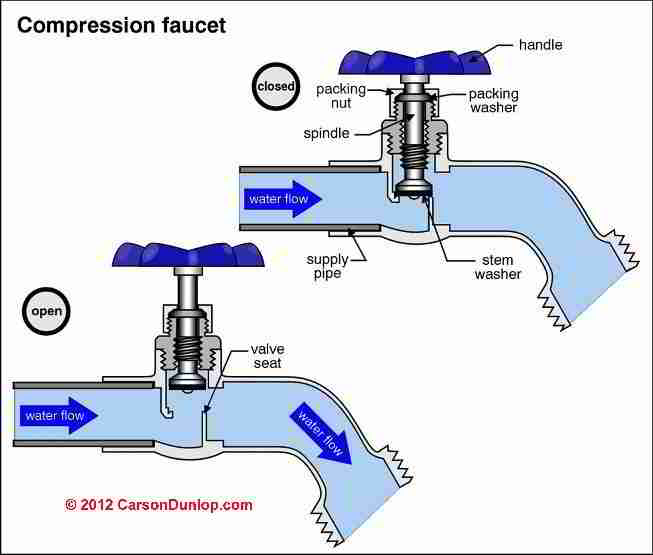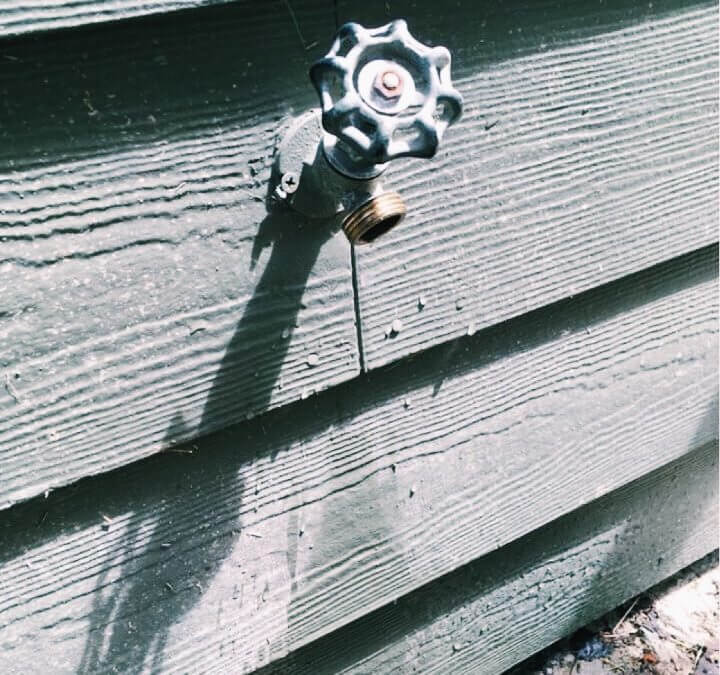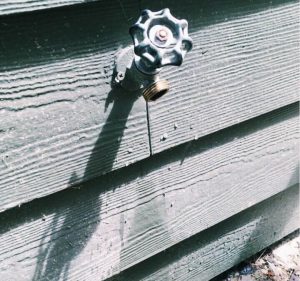Let’s talk about hose bibbs. Sometimes called an outdoor faucet (and technically termed “sillcock”), a hose bibb is a valve where you attach your garden hose. And since summer is when you’ll usually use that hose the most, it’s a good idea to have some basic understanding of how a hose bibb works, which is what we’ll cover today–along with some maintenance tips and tricks.
Anatomy of a Hose Bibb
First, let’s go over the anatomy of a hose bibb. The most common type of valve used is a compression type, where the handle rotates to screw the stem or spindle into the seat, thus sealing the opening and stopping the water flow (see diagram). These valves are effective, but, like everything else, they degrade over time.
As you see in the picture, the valve has two washers: a stem washer and a packing washer. If you do find that your hose bibb drips from the handle, you can usually simply tighten the packing nut with a small crescent wrench (or similar tool) and get it to stop.
If you notice the whole thing dripping even when it’s closed, it’s a sign your stem washer is bad. In this case, I can’t recommend anything other than calling a professional–being outside exposed to weather makes hose bibbs both very hard to take apart and very easy to break if done wrong (sometimes even we encounter one that we can’t get apart, in which case the whole thing should be replaced).

Indoor Shutoff Valve for Hose Bibbs
Next, let’s touch on indoor shutoff valves for hose bibbs. Every outside faucet should have an inside valve that controls water flow before it reaches the outside for winterization purposes (note I said “should,” although inevitably there will be some installed without these). While the location of these indoor valves can vary, they’re most commonly found under your sinks.
If you’ve ever looked under a kitchen or bathroom sink and noticed a valve coming off the cold side and back into the wall or floor, odds are that it’s a hose bibb shutoff. If you have a hose bibb that no water comes out of, there’s probably an interior shutoff for it that’s been closed at some point. If you can track it down, you’ll solve your own problem.
Indoor valves are mainly used to help winterize outdoor faucets as I mentioned above. Since hose bibbs are exposed to freezing temperatures during the winter, they can burst if they’re full of water. To prevent this, simply close the indoor valve, open the outdoor one, and let the water flow out–oh, and make sure you disconnect your hose, too!
Actually, disconnecting the hose after every use is good practice in general as it keeps the hose from fusing to the faucet (as discussed in my article on galvanic corrosion), and you’ll be able to see easily if you have a drippy faucet.
Maintenance Tips for Longevity
Regular maintenance extends the life of your hose bibb and ensures it operates efficiently. Here are some additional tips:
- Seasonal Inspections: Beyond checking for drips, inspect the hose bibb for corrosion, wear, or damage at the start and end of the summer season.
- Lubrication: Apply a silicone-based lubricant to the stem annually to ensure smooth operation and prevent sticking.
- Protective Covers: Use insulated covers during winter to protect against freezing, even if you’ve drained the water.
Troubleshooting Common Issues
While tightening a packing nut or replacing a washer can fix minor leaks, some issues require more attention:
- Hard Water Deposits: Mineral buildup can cause the valve to stick or leak. Vinegar soaks can dissolve minor buildup, but severe cases may need professional cleaning.
- Frost Damage: Even with preventive measures, extreme winters can cause frost damage. Check for cracks or signs of leakage when the weather warms.
Professional Care: When to Call a Plumber
While DIY maintenance can handle many hose bibb issues, some situations necessitate professional expertise:
- Severe Leaks: If basic troubleshooting doesn’t stop the leak, it may indicate a deeper issue within your plumbing system.
- Installation and Replacement: Proper installation is crucial to prevent future problems. If a hose bibb needs replacement, especially one that’s difficult to remove or in a complex plumbing system, a professional ensures it’s done right.
Upgrades and Innovations
Consider upgrading to frost-proof hose bibbs or models with built-in backflow prevention. These modern alternatives provide added protection against freezing temperatures and ensure that your home’s water supply remains uncontaminated by outdoor sources.
Schedule a Plumber
Schedule a plumber if you need assistance with your hose bibb, we are happy to help.
Read our reviews to learn more about us or our plumbing services.

